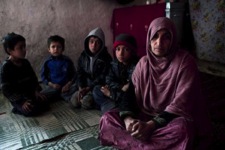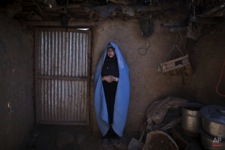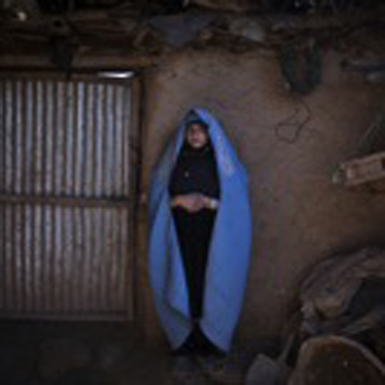Summing up mounting pressures and trying to find a way to leave Iran, Sabeen, a mother of three, stated:
Don’t push me to go by boat… I’ve tried my chances and unfortunately I couldn’t find a way. The only thing that I found is this. You say to me it is a terrible way. You say it is not a safe way. You say to me it is a dangerous way. Everything you say I believe in it, but I have no other way. Sabeen (45 years old)
Problems of Push
 Triggers of movement are complex for refugee mothers and, as the above quote makes clear, many feel they have little choice other than to migrate. There’s no one reason, nor can the decision to move be boiled down simply to fear. Examining these migration motivations isn’t to say that mothers don’t cite fear for their lives as a reason for migration. However, there are specific gendered triggers of movement for these mothers which are also affected by other factors, such as country of origin and class. Theory around push and pull factors is often credited to Everett Lee’s work on migration in which he outlines how people (in this case, men) decide to leave ‘origin’ countries and move to ‘destination’ countries. Push factors can be defined in a multitude of ways, on levels from macro to micro reasons (see, for example, work by Silvia Pedraza and Saskia Sassen-Koob) which contribute to life situations which cause, in the words of Guido Dorigo and Waldo Tobler, someone to ‘be dissatisfied with one’s present locale.’ This definition cannot fully encompass the complications around why people migrate and how these may culminate in a migratory journey. Push factors as a terminology may also dismiss the agency in decisions to migrate. Beyond these issues, women travelling with children clearly extend the framework of decision-making beyond an individualised model of push and pull factors which have been previously discussed within the literature. Due to the problematic nature of the push/pull dichotomy, I’ve chosen to use ‘migration motivations’ and ‘triggers of movement’ instead of ‘push factors.’
Triggers of movement are complex for refugee mothers and, as the above quote makes clear, many feel they have little choice other than to migrate. There’s no one reason, nor can the decision to move be boiled down simply to fear. Examining these migration motivations isn’t to say that mothers don’t cite fear for their lives as a reason for migration. However, there are specific gendered triggers of movement for these mothers which are also affected by other factors, such as country of origin and class. Theory around push and pull factors is often credited to Everett Lee’s work on migration in which he outlines how people (in this case, men) decide to leave ‘origin’ countries and move to ‘destination’ countries. Push factors can be defined in a multitude of ways, on levels from macro to micro reasons (see, for example, work by Silvia Pedraza and Saskia Sassen-Koob) which contribute to life situations which cause, in the words of Guido Dorigo and Waldo Tobler, someone to ‘be dissatisfied with one’s present locale.’ This definition cannot fully encompass the complications around why people migrate and how these may culminate in a migratory journey. Push factors as a terminology may also dismiss the agency in decisions to migrate. Beyond these issues, women travelling with children clearly extend the framework of decision-making beyond an individualised model of push and pull factors which have been previously discussed within the literature. Due to the problematic nature of the push/pull dichotomy, I’ve chosen to use ‘migration motivations’ and ‘triggers of movement’ instead of ‘push factors.’
Migration and Motherhood Project
This post draws on my doctoral research in which I’m speaking with asylum-seeking and refugee mothers from Iran and Afghanistan on how these women negotiate their security, agency, and mobility within the context of illegalised migration to Australia. In the context of semi-structured interviews to discuss the crossroads between motherhood and migration, the women have shared a variety of migratory experiences with me. Speaking to these two groups of women isn’t meant to structure a strict comparative study between them. Rather, the inclusion of both groups permits a wider range of intersections to be analysed, such as those between the situations in home countries, paths of migration, class, and differing gender roles within the family context. In what follows, I touch on some of the initial themes surrounding migration from these mothers.
Emergent Triggers
Migration motivations for these mothers are important as there’s a lack of understanding around the experiences of this context. This project begins to uncover what it might be like to be faced with extreme situations of migration with children in tow or how the complicating factors of pregnancy might affect migration. These additional factors affect the fundamental foundations of why people are on the move and are necessary to explore in order to better support these populations before, during, and after their migratory journeys.
Many of the women I spoke with discussed family abuses and structural issues around gender roles in their home countries within their motivation to migrate. These underlying structural barriers were tied with policies that for the allowed abuse, control, and confinement of women by family members and partners. This wasn’t just the case in the marital relationship, but rather an extended network of controls which occurred in women’s home countries:
She forced for this marriage and she doesn’t like him…her husband was 40 and she was 15 and not understand…she asked him if he wanted to go, not stay, because he hits and lots of problems happened….He forced me to stay in the house, all the time when I’d go out, I’d have something to do, he just forced me to get back to the house because in the community in Iran, no woman goes out. She mustn’t because she is under his hand. He has influence on her because they are marries and the government and the law—she cannot go out. Roya (late 30s, mother of one son)
Other gendered triggers of movement emerged in the narratives which could be tied to other conditions within home countries. For instance, Afghan women were more likely to talk about general personal safety as mothers in a war zone faced with a lack of access to education for themselves and their daughters. Iranian women were more likely to speak of/about direct government harassment of themselves and their children as factors influencing their decision to migrate. Both groups spoke of/about pregnancy being a trigger. Sometimes they were unmarried. At other times they were concerned about the safety of their unborn child.
 It’s clear that borders are permeable for some and not for others. Captured quite clearly by David Lyon’s use of the term ‘social sorting,’ this border permeability is distinguished along the lines of gender, nationality, and class. It’s already difficult to enter a country’s borders for asylum seekers, but within these distinctions is the ability to choose the mode of travel and other options. This ‘ability to choose’ is, of course, must be understand in the rigid constraints of Australian border controls.
It’s clear that borders are permeable for some and not for others. Captured quite clearly by David Lyon’s use of the term ‘social sorting,’ this border permeability is distinguished along the lines of gender, nationality, and class. It’s already difficult to enter a country’s borders for asylum seekers, but within these distinctions is the ability to choose the mode of travel and other options. This ‘ability to choose’ is, of course, must be understand in the rigid constraints of Australian border controls.
Class impacted on some gendered migration motivations, specifically in the realm of transport within these women’s stories. Iranian families, many of whom had higher socio-economic statuses, were able to afford the more immediate and costly option of travelling by boat. Afghan women, despite their wish to travel by boat with their male partners, were more likely to spend long periods of time in Pakistan while their partners negotiated their way to Australia and gained permanent status. Indeed, migrating by boat wasn’t an easy option:
She said because it’s very difficult to come [by boat]…Because of the cost and because of the safety. Zarlashta (29 years old, mother of two).
This short blog post cannot touch on each of the themes which have emerged to create the various pressures for mothers to move from their home country. All of the women with whom I’ve spoken were in some way in fear of their lives or the lives of their children. However, this project has illuminated that this process is more complicated than simple danger and is tied up with structural gendered issues that are confounded by class and country of origin. It’s my intention to further pull apart these complicated motivations in order to form an understanding of how asylum-seeking mothers begin their hazardous journeys from their home countries.
Author affiliation: Brandy Cochrane, PhD Candidate, School of Social Sciences and Researcher, Border Crossing Observatory, Monash University
This post is part of the joint blog series on ‘Gender and Migration’ co-hosted by Border Criminologies and COMPAS. Posts in this series will be published on both blogs every Friday until the end of June.
